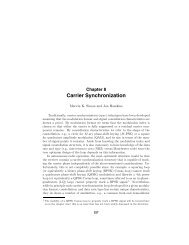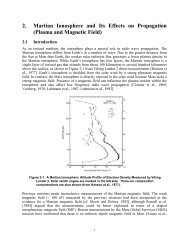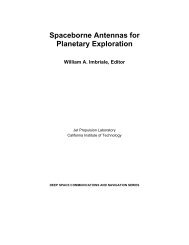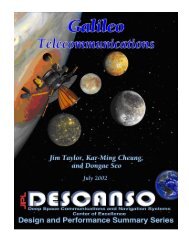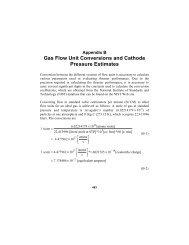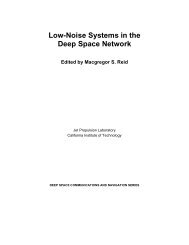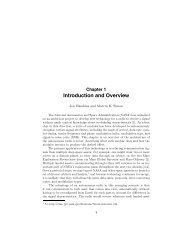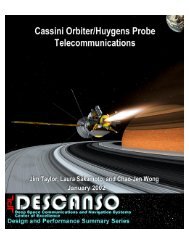Propagation Effects Handbook for Satellite Systems - DESCANSO ...
Propagation Effects Handbook for Satellite Systems - DESCANSO ...
Propagation Effects Handbook for Satellite Systems - DESCANSO ...
Create successful ePaper yourself
Turn your PDF publications into a flip-book with our unique Google optimized e-Paper software.
6.4.2.3 Statistics of Microwave <strong>Effects</strong> of Clouds. A JPL study<br />
(Slobin 1982), has made estimates of the statistics of cloud effects<br />
<strong>for</strong> the continental U.S., Alaska and Hawaii. The presence of clouds<br />
in space-earth downlink antenna beams has two primary effects:<br />
signal attenuation and an increase in system noise temperature.<br />
For very low-noise receiving systems, such as those used <strong>for</strong> deepspace<br />
communicationa the noise effect can be quite significant.<br />
l<br />
Cloud noise statistics may there<strong>for</strong>e be important in siting such<br />
systems and in scheduling their use. Cloud effects can normally be<br />
ignored in a high-reliability system designed with a rain margin.<br />
.- Howeverf clouds must be considered <strong>for</strong> systems with minimal margin<br />
that are intended <strong>for</strong> continuous use, such as a deep-space link<br />
receiving unrepeatable spacecraft data.<br />
The JPL study determined that the U.S. could be divided into<br />
fifteen regions of statistically “consistent” clouds, as shown in<br />
Figure 6.4-2. The region boundaries shown in the figure are highly<br />
stylized and should be interpreted liberally. Some boundaries<br />
coincide with major mountain ranges (Cascades? Rockiest and Sierra<br />
Nevada), and similarities may be noted between the cloud regions and<br />
the rain rate regions of the Global Model. Each cloud region is<br />
considered to be characterized by observations at a particular<br />
National Weather Service observation station. The locations and<br />
three-letter identifiers of these stations are shown in the figure.<br />
For each of these stations, an “average year” was selected on the<br />
basis of rainfall measurements. The “average year” was taken to be<br />
the one in which the year’s monthly rainfall distribution best<br />
matched the 30-year average monthly distribution. Hourly surface<br />
observations <strong>for</strong> the “average year” <strong>for</strong> each station were used to<br />
derive cumulative distributions of zenith attenuation and noise<br />
temperature due to oxygen, water vapor, and clouds,<br />
frequencies ranging from 8.5 to 90 GHz.<br />
<strong>for</strong> a number of<br />
The following method was employed to calculate<br />
distributions.<br />
6-67<br />
the cumulative





